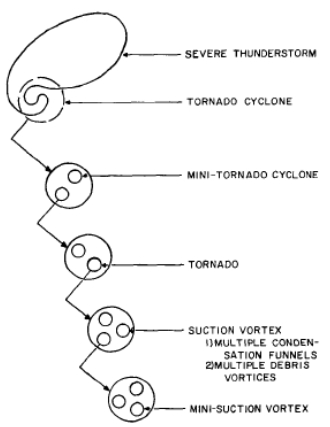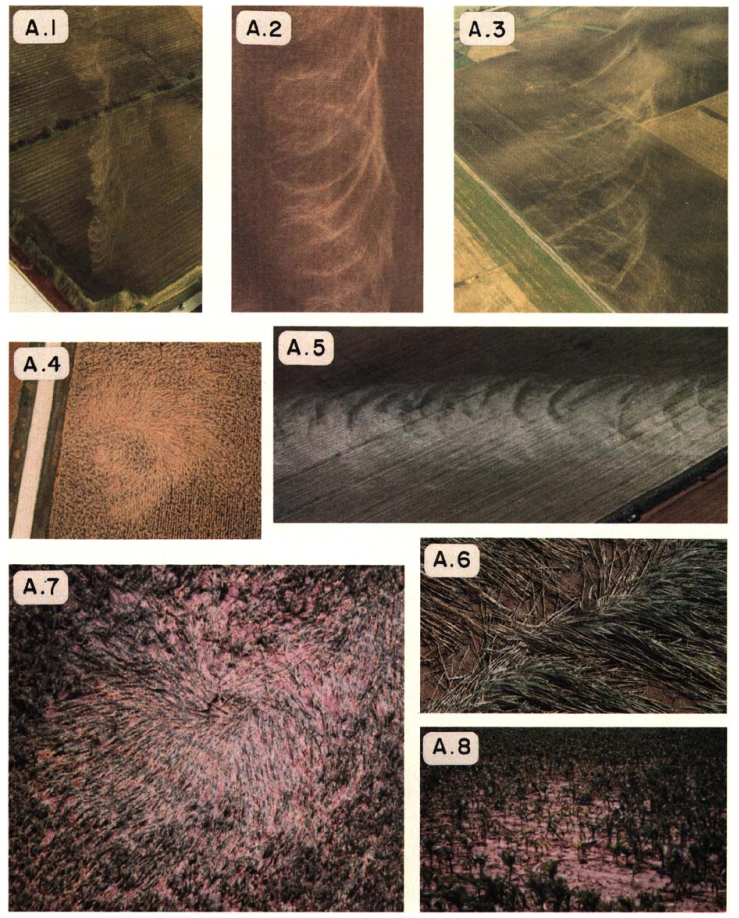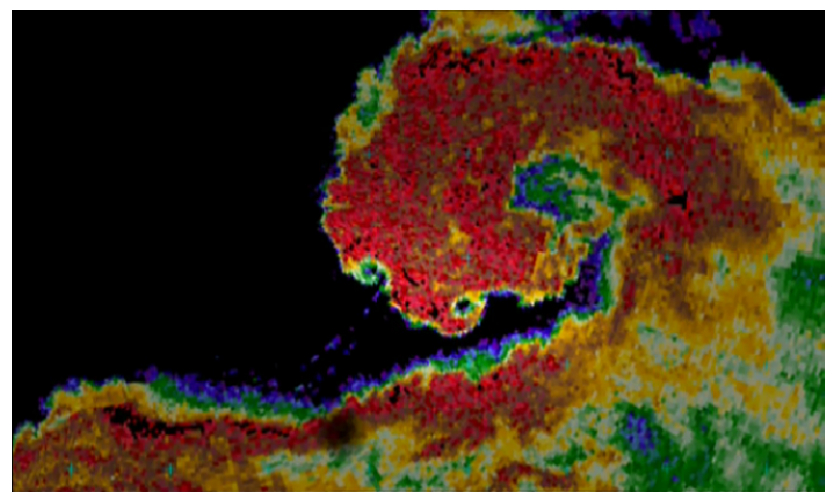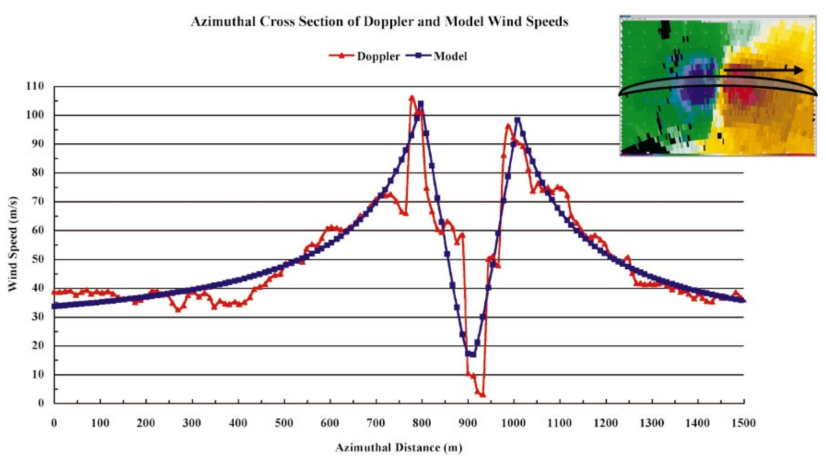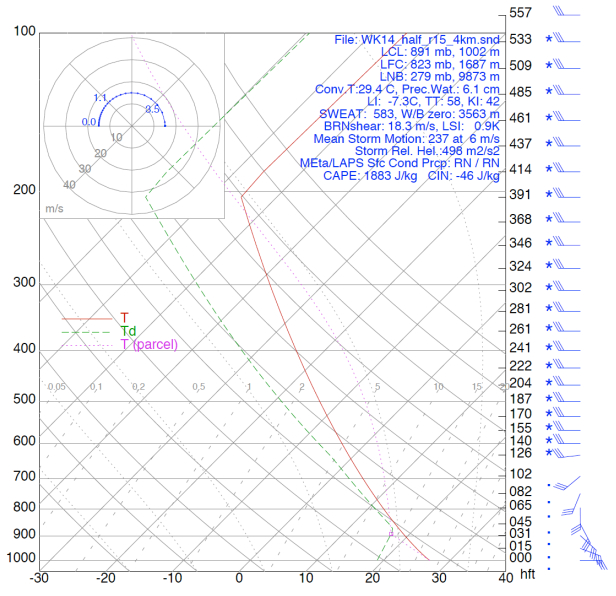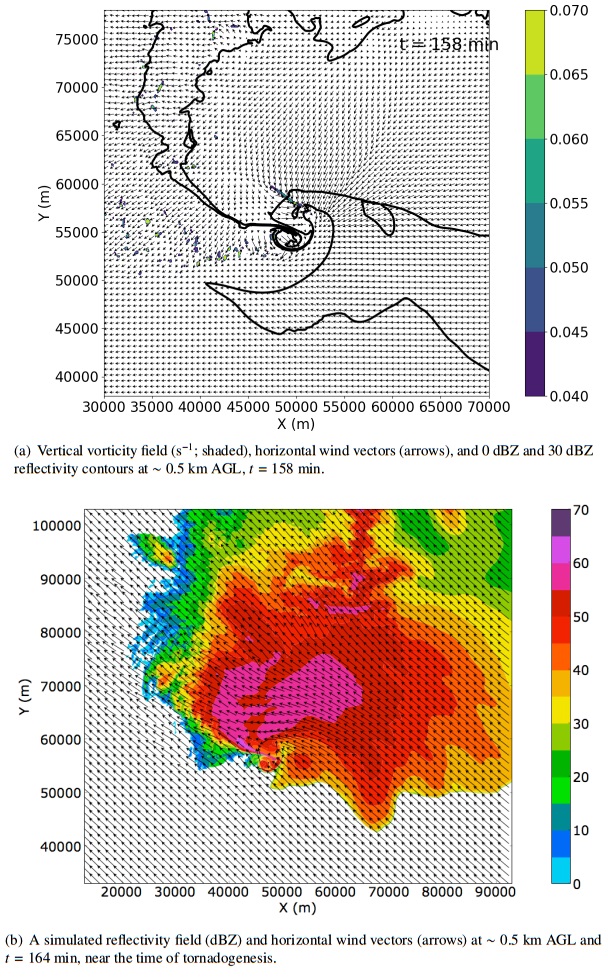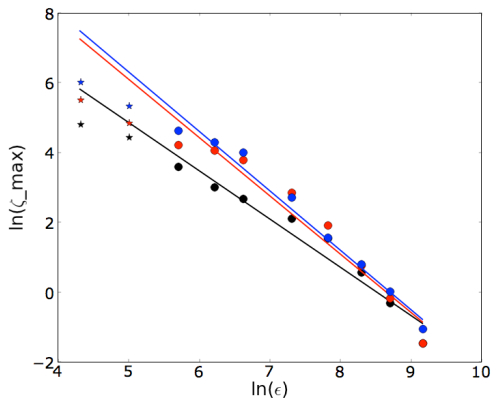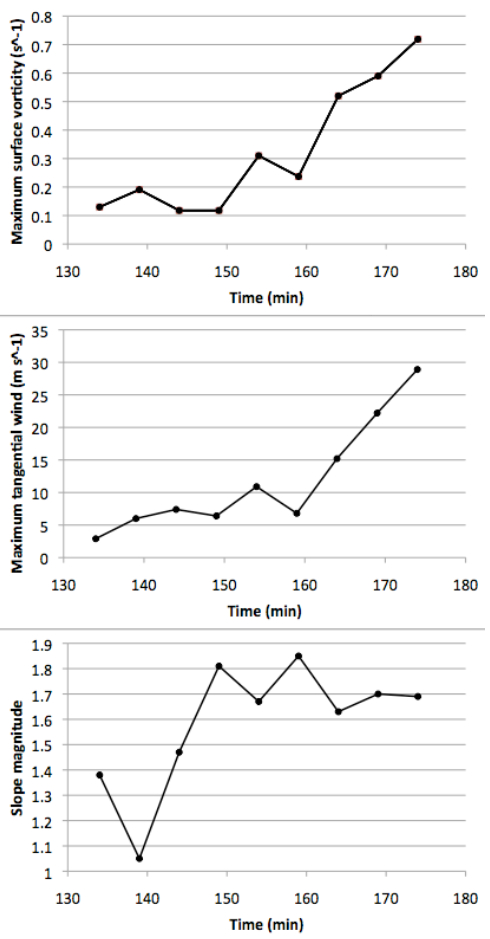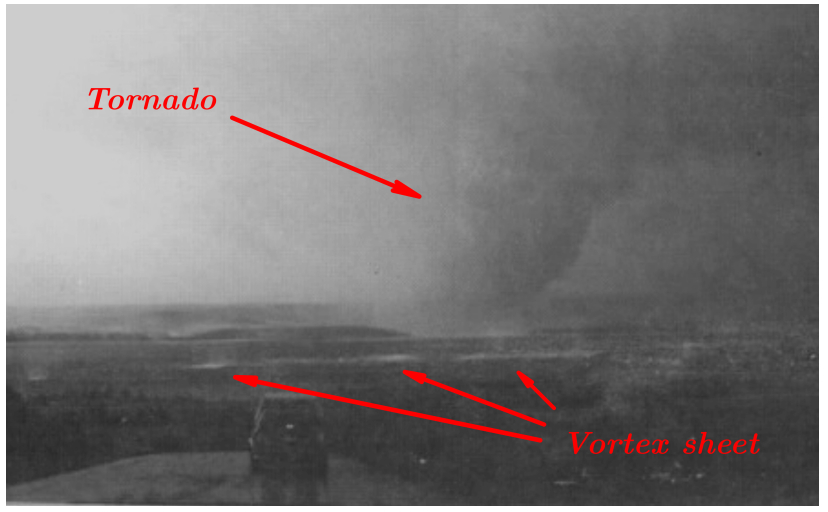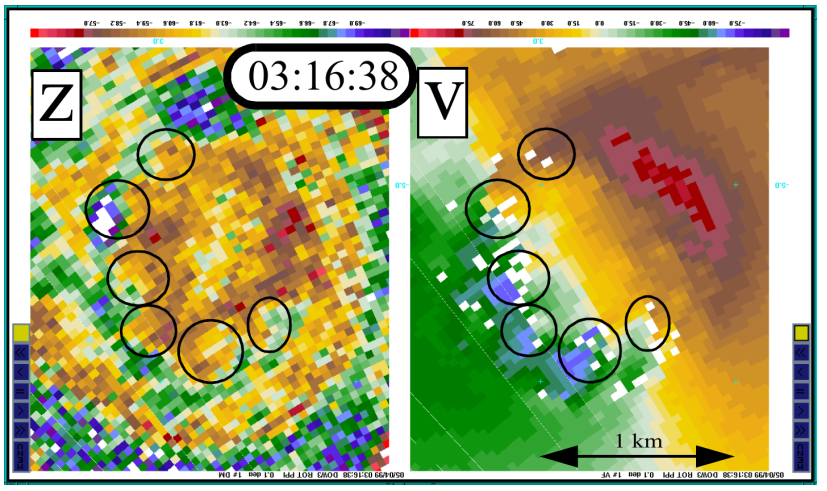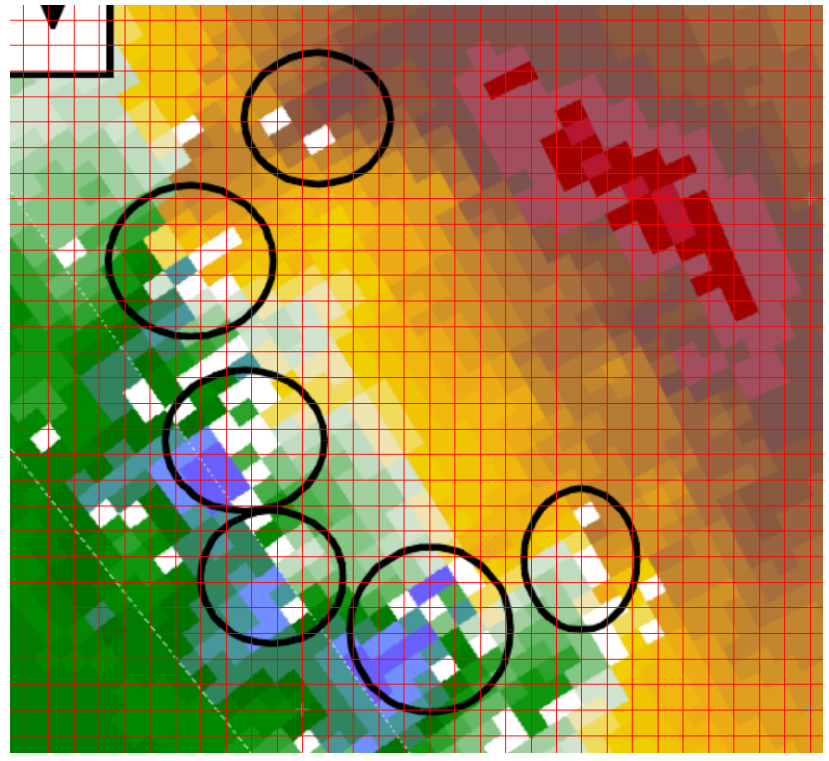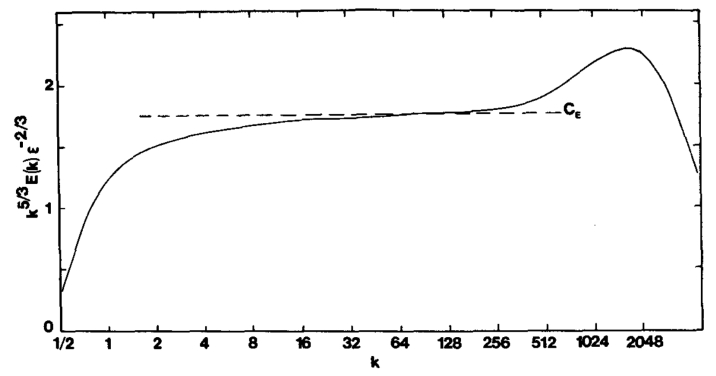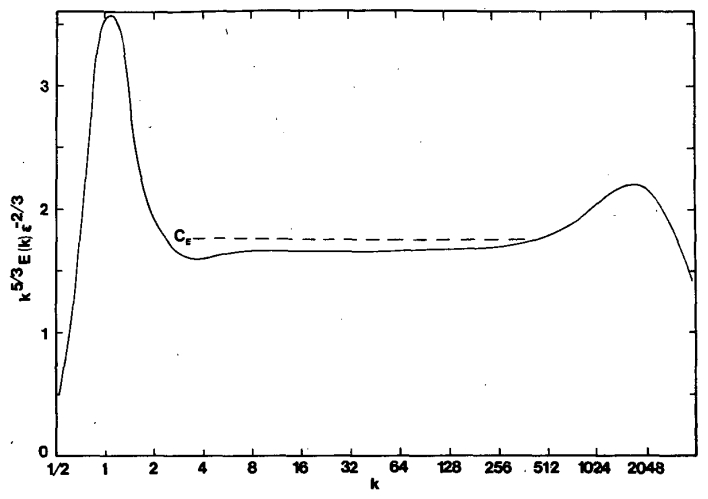Self-similarity in tornadic and some non-tornadic supercell flows is studied and power laws relating various quantities in such flows are demonstrated. Magnitudes of the exponents in these power laws are related to the intensity of the corresponding flow and thus the severity of the supercell storm. The features studied in this paper include the vertical vorticity and pseudovorticity, both obtained from radar observations and from numerical simulations, the tangential velocity, and the energy spectrum as a function of the wave number. Power laws for the vertical vorticity, pseudovorticity, and tangential velocity obtained from radar observations studied in the literature are summarized. Further support is given to the existence of a power law for vorticity by the analysis of data obtained from a numerical simulation of a tornadic supercell. A possible explanation for an increase in vorticity in a developing tornado is provided, as well as an argument that tornadoes have approximate fractal cross sections and negative temperatures. A power law that relates the increase of the approximate fractal dimension of the cross section of a negative temperature vortex to its energy content is derived, and the possible applicability of the box-counting method to determine this quantity from suitable radar images is demonstrated.
1.
Introduction
Throughout this article, we only deal with finite and simple graphs. For the undefined notation and terminology, one may refer to [4]. Let G=(V(G),E(G)) be a graph. The open neighborhood of a vertex v∈V is denoted by NG(v)={u∈V:uv∈E(G)}, and the degree of v in G is denoted by d(v)=|NG(v)|. A graph G is k-regular if every vertex has degree k in G. We use δ(G) and Δ(G) denote the minimum degree and the maximum degree among the vertices of G, respectively. For a subset S⊆V(G), let G[S] denote the subgraph induced by S. For simplicity, the induced subgraph G[V(G)∖S] is denoted by G−S. For two disjoint subsets X,Y⊂V(G), we use e(X,Y) to denote the number of edges with one end in X and the other end in Y. The Cartesian product G◻H of two graphs G and H is the graph with vertex set V(G◻H)=V(G)×V(H), and edge (u1,v1)(u2,v2)∈E(G◻H) if and only if either u1=u2 and v1v2∈E(H) or v1=v2 and u1u2∈E(G). In general, let Pn, Cn denote a path, a cycle of order n, respectively.
A total dominating set of G is a subset S⊆V(G) such that each vertex in V(G) has a neighbor in S. The total domination number γt(G) is the cardinality of a minimum total dominating set of G. The notion of total domination in graphs was first introduced by Cockayne et al. [8]. Numerous results on this object have been obtained over the years. Reader may refer to an excellent total domination book [12] and a survey [9]. A problem on total domination appeared as Question 3 of the 40th International Mathematical Olympiad, which is equivalent to determining the total domination number of the Cartesian product of two path graphs with same even order, i.e. γt(P2n◻P2n). And further, several authors have studied the total domination number on product of graphs such as Cartesian, strong and lexicographic products (see [2,6,13,14,16,19]).
Except the classical total domination problem, there are many different ways to generalize the total dominating set. One of them is introduced by Henning and Kazemi in [10,11]: Given an integer k, a subset S⊆V(G) is a k-tuple total dominating set (kTDS in short) of G if every vertex v∈V(G) has |N(v)∩S|≥k, this is, every vertex of G has at least k neighbors in S. The k-tuple total domination number γ×k,t(G) is the cardinality of a minimum kTDS of G. Henning and Kazemi [10] first studied the k-tuple total domination number, and obtained some results of the k-tuple total domination number of complete multipartite graphs. They also gave a useful observation.
Observation 1.1. [10] Let G be graph of order n with δ(G)≥k. Then,
(a) γ×k,t(G)≤n;
(b) if G is a spanning subgraph of graph H, then γ×k,t(H)≤γ×k,t(G);
(c) if v is a vertex with degree k in G and S is a kTDS in G, then NG(x)⊆S.
We remark that 1-tuple total domination is the well-known total domination. When k=2, a k-tuple total dominating set is called a double total dominating set, abbreviated to DTDS, and the 2-tuple total domination number is also called the double total domination number, denoted by γ×2,t(G). This parameter was studied in [1,3,5,7,15,17,18]. Especially, Kazemi et al. [15] determined the value of the double total domination number of Cartesian product of some complete graphs. Bermudo et al. [3] gave the following result on the double total domination number.
Theorem 1.2. [3] Let j≥2,n≥3 be two integers. Then,
(a) when j is odd, γ×2,t(Pj◻Cn)=(j+1)n2;
(b) when j is even, γ×2,t(Cj◻Cn)=jn2.
Naturally, we may ask the following problem: What are the values of the double total domination numbers of Cartesian products of paths? In order to answer the problem, we make a step in this paper. In the next section, we give the values of γ×2,t(Pi◻Pn) for i=2,3, and the lower and upper bounds for γ×2,t(Pi◻Pn) when i≥4.
2.
Double total domination number of Cartesian product of paths
In this section, we simplify the notation for V(Pm◻Pn). For example, when m=4, if P4=abcd, Pn=v1v2…vn, we denote simply the vertices (a,vi) as ai, (b,vi) as bi, (c,vi) as ci, (d,vi) as di, respectively. Moreover, set Xi={ai,bi,ci,di} for 1≤i≤n.
First, we give a lower bound for the double total domination number of P2◻Pn.
Lemma 2.1. Let n≥2 be an integer. Then
Proof. Let P2=ab, Pn=v1v2…vn, and Xi={ai,bi} for 1≤i≤n. Denote G=P2◻Pn. Pick a minimum DTDS D of G. Since δ(G)=2 and Δ(G)=3, then D=D2∪D3, where Di={v∈D:|N(v)∩D|=i} for i∈{2,3}. Note that Xi⊆D (i=1,2,n−1,n) by Observation 1.1 (c). Then, when n≤4, we have |D|=|V(G)|=2n, as desired. Next, we consider the case that n≥5.
Let ¯D=V(G)∖D. First, we claim that
The first inequality holds because every vertex in ¯D is adjacent to at least two vertices in D, and the second one holds because e(X1∪Xn,¯D)=0 and each of the remaining |D|−4 vertices has at most Δ−2 neighbors in ¯D. Therefore
Since γ×2,t(G) is an integer, the result holds when n≡0(mod3) or n≡2(mod3).
The remaining case is n=3k+1, where k≥1 is an integer. We apply induction on k. For k=1, G=P2◻P4. As discussed above, γ×2,t(G)=2n=4×4+83. Suppose that the result holds for k−1, where k≥2. Our goal is to prove that it is also valid for k. Recall that Xi⊆D (i=1,2,n−1,n). If D contains at least two vertices in X3∪Xn−2, then there are at least two vertices in X2∪Xn−1 that are not adjacent to any vertex in ¯D. Furthermore, there are at least six vertices in X1∪X2∪Xn−1∪Xn which are in D and not adjacent to any vertex in ¯D. Therefore, we have e(D,¯D)≤(|D|−6)(Δ−2)=|D|−6. On the other hand, e(D,¯D)≥2|¯D|=2(|V(G)|−|D|). Then |D|≥4n+63=12k+103. So |D|≥12k+123=4n+83 because |D| is an integer. If D contains at most one vertex in X3∪Xn−2, without loss of generality, we may assume X3∩D=∅. By definition of the double total dominating set, we know X4⊆D and then X5⊆D. Note that, when n=7, X5=Xn−2. This belongs to the preceding case. When n≥10, set X=X1∪X2∪X3 and G′=G−X. Let D′=D∖X=D∖(X1∪X2). It is easy to see that D′ is a DTDS of G′. By induction,
Thus we have |D|=|D′|+4≥4n+83.
Next we determine the value of γ×2,t(P2◻Pn).
Theorem 2.2. Let n≥2 be an integer. Then
Proof. Let Xi be defined as earlier in the proof of Lemma ???, where 1≤i≤n. Let G=P2◻Pn. When n≤4, it is as desired. Next we assume that n≥5.
We will show the upper bound through constructing a DTDS S of G. Let
By Observation 1.1 (c), X′ is contained in every DTDS of G. When n=3k, set S=X′∪(∪k−1i=1X3i+1)∪(∪k−2i=1X3i+2). Then |S|=8+2(k−1)+2(k−2)=4n+63. Therefore γ×2,t(G)≤|S|=4n+63. When n=3k+1, set S=X′∪(∪k−1i=1X3i+1)∪(∪k−1i=1X3i+2). Then,
Finally, when n=3k+2, set S=X′∪(∪k−1i=1X3i+1)∪(∪k−1i=1X3i+2). Clearly,
Also, by Lemma 2.1, the proof is completed.
For γ×2,t(P3◻Pn), we give a lower bound firstly. Before that, we need an observation.
Observation 2.3. Let G=Pm◻Pn, X=∪hi=1Xi and G′=G−X, where h is a positive integer and h<n. If D is a DTDS of G, then we can obtain a "nearly" DTDS, D∖X, of G′ by confining D on G′. (Each of V(G′)∖Xh+1 has at least two neighbors in D∖X.) Extend some vertices to D∖X, and denote the resulting set by D′. If each vertex in Xh+1 has at least two neighbors in D′, then D′ is a DTDS of G′.
Lemma 2.4. Let n≥2 be an integer. Then
Proof. Let G=P3◻Pn with P3=abc and Pn=v1v2…vn, and D be a minimum DTDS of G. Set Xi={ai,bi,ci} for 1≤i≤n.
First, we introduce three constructions in Figure 1. (In the remaining, for the figures of the paper, a hollow dot denotes a vertex in D, a cross dot denotes a vertex not in D.) If bi∉D (2≤i≤n−1), then {ai−1,ai+1,ci−1,ci+1}⊆D because either of ai and ci must have at least two neighbors in D (see construction (Ⅰ)). If {ai,ci}∩D=∅ (3≤i≤n−2), then {ai−2,ai+2,bi−1,bi+1,ci−2,ci+2}⊆D because each of {ai−1, ai+1, ci−1, ci+1} has at least two neighbors in D (see construction (Ⅱ)). If Xi∩D=∅ (3≤i≤n−2), then Xi−1∪Xi+1∪{ai−2,ai+2,ci−2,ci+2}⊆D by the definition of DTDS (see construction (Ⅲ)).
We prove the lemma by induction on n. When n=2, the result holds by Theorem 2.2. According to Observation 1.1(c), we have the following conclusions for 3≤n≤5. When n=3, we have {b1,a2,c2,b3}⊆D. Focusing on vertices b1,b3, at least two of a1,b2,c1 and at least two of a3,b2,c3 are in D. It implies that γ×2,t(P3◻P3)≥7. We give a DTDS with 7 vertices in Figure 2(a). When n=4, we have {a2,a3,b1,b4,c2,c3}⊆D (see Figure 2(b)). On each dash curve, there are at least two vertices contained in D by the definition of DTDS. Thus, γ×2,t(P3◻P4)≥10. When n=5, we know that {b1,a2,c2,a4,c4,b5}⊆D. Furthermore, on each dash curve, there are at least two vertices contained in D (see Figure 2(c)). Thus |D|≥10. If {a3,c3}∩D=∅, then D would contain all vertices of ∪i=1,2,4,5Xi by construction (Ⅱ), which means that |D|≥12. If {a3,c3}∩D≠∅, then |D|≥11. Thus γ×2,t(P3◻P5)≥11 in either of these cases. (We give a minimum DTDS of G with 11 vertices in Figure 2(d) when n=5.)
When n=6, {a2,a5,b1,b6,c2,c5}⊆D, at least 2 vertices of NG(b1), NG(b6) are contained in D, respectively. If |(X3∪X4)∩D|≥4, we are done. Consider the cases that |(X3∪X4)∩D|≤3. Without loss of generality, we may assume |X3∩D|≤1. If X3∩D=∅, then X1∪X2∪X4⊆D by construction (Ⅲ), so γ×2,t(P3◻P6)≥14 (see Figure 2(e)). If X3∩D={c3} (similarly, for X3∩D={a3}), then {a2,a4,c2,c4}⊆D by construction (Ⅰ). Furthermore, {a1,b2,b4}⊆D because a3∉D. Thus γ×2,t(P3◻P6)≥14 (see Figure 2(f)). If X3∩D={b3}, then {a1,a5,b2,b4,c1,c5}⊆D by construction (Ⅱ) (see Figure 2(g)). If b5∉D, then {a4,a6,c4,c6}⊆D by construction (Ⅰ). If b5∈D, noting that a5 (c5) has at least two neighbors in D, at least one of a4 and a6 (c4 and c6) is in D. In either of these cases, γ×2,t(P3◻P6)≥14.
Next, we only discuss the case n≡0(mod2), and the argument of case n≡1(mod2) is similar by replacing 2n+2 with 2n+1. Assume that the result holds for n−2 where n≥8. Suppose, to the contrary, γ×2,t(G)<2n+2. Next, we will choose a vertex subset X. Let G′=G−X. Then, basing on a DTDS D of G, we obtain a DTDS D′ of G′. Finally, we deduce contradictions according to the relation between |D| and |D′| and induction on index n.
By Observation 1.1 (c), we have {a2,b1,c2}⊆D. Focusing on b1, it is clear that at least two of a1,c1,b2 are contained in D. This means that |D∩(X1∪X2)|≥5. If |D∩(X1∪X2)|=6 and |D∩(X3∪X4)|≥4, then we can extend the missing vertices of X3∪X4 (with at most two) to D∖(X1∪X2) and obtain a vertex set D′=(D∖(X1∪X2))∪(X3∪X4). Then |D′|≤|D|−6+2<2n−2. By Observation 2.3, D′ is a DTDS of G′=G−(X1∪X2). By induction, |D′|≥γ×2,t(G′)≥2(n−2)+2=2n−2, a contradiction. Similarly, if |D∩(X1∪X2)|=5 and |D∩(X3∪X4)|≥5, then we also can obtain a contradiction. Since either of a3, c4 has at least two neighbors in D, we know that at least one of a4 and b3 (c3 and b4, respectively) in D. That is to say, |D∩(X3∪X4)|≥2. Therefore, we only need discuss the following two cases to complete the proof.
Case 1. |D∩(X1∪X2)|=6 and 2≤|D∩(X3∪X4)|≤3.
Case 1.1. If |D∩(X3∪X4)|=3, we claim that either D′=(D∖∪4i=1Xi)∪{a3,b3,a4,b4,c4} or D′=(D∖∪4i=1Xi)∪{b3,c3,a4,b4,c4} is a DTDS of G′=G−(X1∪X2). (For otherwise, focusing on vertices a4,c4, there would be {a3,c3,b4}⊆D and a5,c5∉D. Also, |D∩(X3∪X4)|=3 means that b3∉D. By construction (Ⅰ), a4,c4∈D, then |D∩(X3∪X4)|≥5, a contradiction.) There is |D′|≥γ×2,t(G′)≥2(n−2)+2=2n−2. On the other hand, |D′|=|D|−9+5<2n−2, a contradiction.
Case 1.2. If |D∩(X3∪X4)|=2, then at least one of pairs {a3,a4},{b3,b4},{c3,c4} does not intersect with D. If {b3,b4}∩D=∅, then {a3,c3,a4,c4}⊆D by construction (Ⅰ), a contradiction. By symmetry, we discuss the case that {a3,a4}∩D=∅. Then there is {a2,b3,b4,a5}⊆D. The condition |D∩(X3∪X4)|=2 implies that {c3,c4}∩D=∅ and furthermore c5∈D. Focusing on vertices a5,c5, we know that {b5,a6,c6}⊆D (see Figure 3(a)). Set X=∪4i=1Xi. Then D′=D∖X is a DTDS of G′=G−X. Clearly, |D′|=|D|−8<2n−6. By induction, |D′|≥γ×2,t(G′)≥2(n−4)+2=2n−6, a contradiction.
Case 2. |D∩(X1∪X2)|=5 and 2≤|D∩(X3∪X4)|≤4.
Case 2.1. If |D∩(X3∪X4)|=4, then D′=(D∖∪4i=1Xi)∪{a3,b3,a4,b4,c4} or D′=(D∖∪4i=1Xi)∪{b3,c3,a4,b4,c4} is a DTDS of G′=G−(X1∪X2). There is |D′|≥γ×2,t(G′)≥2(n−2)+2=2n−2. On the other hand, |D′|=|D|−9+5<2n−2, a contradiction.
Case 2.2. If |D∩(X3∪X4)|=3, we consider two subcases according to b2∈D or not.
(1) b2∉D. By construction (Ⅰ), {a3,c3}⊆D. We claim that b3∈D. (For otherwise, there would be {a4,c4}⊆D by construction (Ⅰ), then |D∩(X3∪X4)|≥4, a contradiction.) |D∩(X3∪X4)|=3 means that X4∩D=∅. By construction (Ⅲ), X5∪{a6,c6}⊆D (see Figure 3(b)). Set X=∪4i=1Xi. Then D′=D∖X is a DTDS of G′=G−X. Clearly, |D′|=|D|−8<2n−6. By induction, |D′|≥γ×2,t(G′)≥2(n−4)+2=2n−6, a contradiction.
(2) b2∈D. By symmetry, we may assume that a1∉D. First, we establish a claim.
Claim. {a3,b3}⊆D.
Since a2 has at least two neighbors in D, clearly a3∈D. Focusing on vertices a3,c4, we know that at least one of b3 and a4 (c3 and b4, respectively) in D (∗). If b3∉D, then {a4,c4}⊆D by construction (Ⅰ). It implies that |D∩(X3∪X4)|≥4, a contradiction. The claim is done.
Recall that one of c3,b4 is in D (see (∗)). If c3∈D, then X4∩D=∅. By construction (Ⅲ), X5∪{a6,c6}⊆D (see Figure 3(c)). Similar to (1), we can deduce a contradiction. If b4∈D, then {c3,a4,c4}∩D=∅. By construction (Ⅱ), there is {b5,a6,c6}⊆D. Also, focusing on c4, we know that c5∈D. Furthermore, focusing on a6, we deduce that a5 or b6 in D (see Figure 3(d)). No matter which one of a5, b6 being in D, D′=D∖∪4i=1Xi is a DTDS of G′=G−∪4i=1Xi. However, there are |D′|=|D|−8<2n−6 and |D′|≥γ×2,t(G′)≥2(n−4)+2=2n−6, a contradiction.
Case 2.3. If |D∩(X3∪X4)|=2, then at least one of pairs {a3,a4},{b3,b4},{c3,c4} does not intersect with D. Similar to the proof of Case 1.2, the unique possibility is {a3,a4,c3,c4}∩D=∅. Focusing on the vertices a2,c2, there is {a1,b2,c1}⊆D. This means that |D∩(X1∪X2)|=6, a contradiction.
In each of these cases, we deduce a contradiction. Therefore, we draw a conclusion that γ×2,t(P3◻Pn)≥2n+2 when n≡0(mod2). It is analogous to verify that γ×2,t(P3◻Pn)≥2n+1 when n≡1(mod2) by replacing 2n+2 with 2n+1 in the above proof.
We are ready to prove our second result.
Theorem 2.5. Let n≥2 be an integer. Then
Proof. When n≡0(mod2), set S=(∪ni=1{ai,ci})∪{b1,bn}. It is clear that S is a DTDS of graph G. Hence γ×2,t(G)≤2n+2.
When n≡3(mod4), i.e. n=4k+3 for some nonnegative integer k, set
(see Figure 4(a) for the case n=7), then |S|=n+4(k+1)=2n+1. When n≡1(mod4), i.e. n=4k+1 for some positive integer k, set
(see Figure 4(b) for the case that n=9), then |S|=n−1+4k+3=2n+1. In these two cases, it is easy to check that S is a DTDS of G. Thus, γ×2,t(G)≤|S|=2n+1 when n≡1(mod2).
By Lemma 2.4, the proof is completed.
Let G=Pm◻Pn with Pm=u1u2…um, Pn=v1v2…vn, where integers m≥2, n≥2. For the vertex ui∈V(Pm) and vj∈V(Pn), we denote simply the vertex (ui,vj) by xij, 1≤i≤m, 1≤j≤n. For each 1≤i≤m and 1≤j≤n, we denote Xj=∪mi=1xij, Yi=∪nj=1xij. Before moving forward, we give a useful lemma.
Lemma 2.6. Let G=Pm◻Pn, where integers n≥4,m≥4, and D be a minimum DTDS of G. Then
Proof. For any vertex set W∈{X1,Xn,Y1,Yn}, we will show at least |W|2 vertices of W in D. W.l.o.g., we pick W=Y1={x11,x12,⋯,x1n}. Set D′=V(G)∖D. Since each vertex of Y1∖{x11,x1n} has degree 3 and either of x11,x1n has degree 2, it is impossible to appear three consecutive vertices in Y1∩D′. (For otherwise, the interior vertex is adjacent to at most one vertex in D, a contradiction.) Moreover, if x∈Y1∩D, then x has at least one neighbor in Y1∩D. By the above discussion and Observation 1.1 (c), we can establish the following four facts.
(F1) The length of any sequence of consecutive vertices is at most two in Y1∩D′.
(F2) The length of any sequence of consecutive vertices is at least two in Y1∩D.
(F3) For every four consecutive vertices in Y1, at least two of them in D.
(F4) {x12,x1(n−1)}⊂D.
Concretely, we discuss the following three cases according to x11,x1n in D or not.
Case 1. {x11,x1n}∩D=∅. By (F2) and (F4), {x12,x13,x1(n−2),x1(n−1)}⊂D. By virtue of (F3), we consider four subcases.
(1.1) n≡0 (mod 4).
Since |(Y1∖{x11,x12,x13,x1n})∩D|≥n−42, |Y1∩D|≥n−42+2=n2.
(1.2) n≡1 (mod 4).
Since |(Y1∖{x11,x12,x13,x1(n−1),x1n})∩D|≥n−52, |Y1∩D|≥n−52+3=n+12.
(1.3) n≡2 (mod 4).
Since |(Y1∖{x11,x12,x13,x1(n−2),x1(n−1),x1n})∩D|≥n−62, |Y1∩D|≥n−62+4=n+22.
(1.4) n≡3 (mod 4).
Since |(Y1∖{x11,x12,x13,x14,x1(n−2),x1(n−1),x1n})∩D|≥n−72, |Y1∩D|≥n−72+4=n+12.
Case 2. |{x11,x1n}∩D|=1. We may assume that x11∉D,x1n∈D. By (F2) and (F4), {x12,x13,x1(n−1),x1n}⊂D. Then we have the following conclusions by (F3).
(1.1) n≡0 (mod 4).
|(Y1∖{x11,x12,x13,x1n})∩D|≥n−42, so |Y1∩D|≥n−42+3=n+22.
(1.2) n≡1 (mod 4).
|(Y1∖{x11,x12,x13,x1(n−1),x1n})∩D|≥n−52, so |Y1∩D|≥n−52+4=n+32.
(1.3) n≡2 (mod 4).
|(Y1∖{x11,x12,x13,x1(n−2),x1(n−1),x1n})∩D|≥n−62, then |Y1∩D|≥n−62+4=n+22.
(1.4) n≡3 (mod 4).
|(Y1∖{x11,x12,x13,x14,x1(n−2),x1(n−1),x1n})∩D|≥n−72, so |Y1∩D|≥n−72+4=n+12.
Case 3. {x11,x1n}⊂D. By (F2) and (F4), {x11,x12,x1(n−1),x1n}⊂D. By (F3), the following are established.
(1.1) n≡0 (mod 4).
By |(Y1∖{x11,x12,x1(n−1),x1n})∩D|≥n−42, |Y1∩D|≥n−42+4=n+42.
(1.2) n≡1 (mod 4).
By |(Y1∖{x11,x12,x13,x1(n−1),x1n})∩D|≥n−52, |Y1∩D|≥n−52+4=n+32.
(1.3) n≡2 (mod 4).
By |(Y1∖{x11,x12,x13,x1(n−2),x1(n−1),x1n})∩D|≥n−62, |Y1∩D|≥n−62+4=n+22.
(1.4) n≡3 (mod 4).
Recall that {x11,x12,x1(n−1),x1n}⊂D. Furthermore, by (F1), |{x13,x14,x15}∩D|≥1. By (F3), |(Y1∖{x11,x12,x13,x14,x15,x1(n−1),x1n})∩D|≥n−72. Thus |Y1∩D|≥n−72+5=n+32.
We will complete the proof by considering all cases dependent on x11,x1n,xm1,xmn in D or not.
(1) If {x11,x1n,xm1,xmn}∩D=∅, then
according to Case 1.
(2) If |{x11,x1n,xm1,xmn}∩D|=1, w.l.o.g., assuming that xm1∈D, then
according to Cases 1 and 2. Similarly, |D∩(X1∪Xn)|≥m+1. Since xm1 is counted twice, we have |D∩(X1∪Xn∪Y1∪Ym)|≥m+n+1.
(3) If |{x11,x1n,xm1,xmn}∩D|=2, then there are two possible subcases to be considered up to isomorphism. If {xm1,xmn}⊂D, then
according to Cases 1 and 3, and |D∩(X1∪Xn)|≥m+1 by Case 2. Noting that either of xm1,xmn is counted twice, |D∩(X1∪Xn∪Y1∪Ym)|≥m+n+1. If {xm1,x1n}⊂D, then
according to Case 2. Since either of xm1,x1n is counted twice, |D∩(X1∪Xn∪Y1∪Ym)|≥m+n.
(4) If |{x11,x1n,xm1,xmn}∩D|=3, then we may assume that x11∉D by symmetry. By Cases 2 and 3,
and similarly |D∩(X1∪Xn)|≥m+2. Noting that each of x1n,xm1,xmn is counted twice, we have |D∩(X1∪Xn∪Y1∪Ym)|≥m+n+1.
(5) If {x11,x1n,xm1,xmn}⊂D, then
by Case 3. Since each of x11,x1n,xm1,xmn is counted twice, |D∩(X1∪Xn∪Y1∪Ym)|≥m+n.
Next, we will give bounds for γ×2,t(Pm◻Pn) when m≥4. When m=4, it is stated as the following theorem.
Theorem 2.7. Let n≥2 be an integer. Then
Proof. Let G=P4◻Pn with P4=abcd and Pn=v1v2…vn, where n≥2. Set Xi={ai,bi,ci,di} for 1≤i≤n, Y1=∪ni=1ai and Y4=∪ni=1di.
We firstly prove the upper bound by constructing a DTDS of G. For integer k≥0, set
Clearly, |X|=12k. Next, we give a DTDS, denoted by S, of G according to the value of n.
When n=5k, set S=X∪{b5k,c5k}. Thus |S|=12k+2=12n5+2. Therefore γ×2,t(G)≤|S|=12n5+2.
When n=5k+1, set S=X∪X5k+1∪{a5k,d5k}. Then γ×2,t(G)≤|S|=12k+6=12n+185.
When n=5k+2, set S=X∪X5k+1∪X5k+2. So γ×2,t(G)≤|S|=12k+8=12n+165.
When n=5k+3, set S=X∪X5k+1∪X5k+3∪{a5k+2,d5k+2}. Then γ×2,t(G)≤|S|=12k+10=12n+145.
Finally, when n=5k+4, set
Hence
Next, let D be a minimum DTDS in G and D′=V(G)∖D. We will prove the lower bound by counting the edges between D and D′. Set W=X1∪Xn∪Y1∪Y4. By Lemma 2.6, |D∩W|≥n+4. Note that each vertex in D∩W has at most one neighbor in D′, and each one in D∖W has at most two neighbors in D′. So
Then
Hence we have |D|≥9n4+1.
Now, we consider the bounds of γ×2,t(Pm◻Pn) for m≥5 and n≥5.
Theorem 2.8. For integers m≥5, n≥5,
Proof. Let G=Pm◻Pn with Pm=u1u2…um, Pn=v1v2…vn, where m≥5, n≥5. For the vertex ui∈V(Pm) and vj∈V(Pn), we denote simply the vertex (ui,vj) by xij, 1≤i≤m, 1≤j≤n. For each 1≤i≤m and 1≤j≤n, we denote Xj=∪mi=1xij, Yi=∪nj=1xij. Let D be a minimum DTDS of G, and D′=V(G)∖D.
Let W=X1∪Xn∪Y1∪Ym. By Lemma 2.6, |D∩W|≥m+n. Counting the edges between D and D′, we have 2(mn−|D|)=2|D′|≤e(D,D′)=e(D∩W,D′)+e(D∖W,D′)≤|D∩W|+2|D∖W|=2|D|−|D∩W|≤2|D|−(m+n). Then γ×2,t(Pm◻Pn)=|D|≥mn2+m+n4.
To prove the upper bounds, for integer k≥1, set
Then |X|=2mk+2k. Next, we give a DTDS of G for each of the possible cases to complete the proof.
Case 1. n=4k.
Let
set S=X∪A∪{x(m−2)4k,x(m−1)4k}. When m≡0(mod4), {x(m−2)4k,x(m−1)4k}⊆A, so |A∪{x(m−1)4k,x(m−2)4k}|=m2. When m≡1(mod4), x(m−2)4k∈A, so |A∪{x(m−1)4k,x(m−2)4k}|=m+12. When m≡2(mod4), |A∪{x(m−1)4k,x(m−2)4k}|=m+22. When m≡3(mod4), |A∪{x(m−1)4k,x(m−2)4k}|=m+12. Hence, |A∪{x(m−1)4k,x(m−2)4k}|≤m+22. Clearly, each vertex in V(G)∖X4k has at least two neighbors in S. For any vertex x∈X4k, x has at least one neighbor in S∩X4k. Noting that X4k−1⊂S, each vertex in X4k has at least two neighbors in S. That is to say, S is a DTDS of G. Thus
Case 2. n=4k+1.
Set S=X∪X4k+1∪{x1(4k),xm(4k)}. Then S is a DTDS of G. So γ×2,t(G)≤|S|=2mk+2k+m+2=mn2+m+n+32.
Case 3. n=4k+2.
Let
When m≡0(mod4), set S=X∪B∪{x(m−1)(4k+2),xm(4k+2)}. Then |S|≤|X|+m+m2+2=|X|+3m+42.
When m≡1(mod4), set S=X∪B∪{x(m−1)(4k+2),xm(4k+2)}. Then |S|≤|X|+m+m−12+2=|X|+3m+32.
When m≡2(mod4), set S=X∪B∪{x(m−1)(4k+2),xm(4k+2)}. Then |S|≤|X|+m+m−22+2=|X|+3m+22.
When m≡3(mod4), set S=X∪B∪(∪mi=m−2{xi(4k+2)}). Then |S|≤|X|+m+m−32+3=|X|+3m+32. In each of these cases, we have
Next, we show that S is a DTDS of G. Clearly, for each vertex x∈V(G)∖(X4k+1∪X4k+2), x has at least two neighbors in S. Noting that X4k+1⊆S, each vertex in X4k+1 has two neighbors in X4k+1 except x1(4k+1) and xm(4k+1). Also, x1(4k+1) (xm(4k+1)) has another neighbor x1(4k+2) (xm(4k+2)) in S. For any vertex x∈X4k+2, x has one neighbor in X4k+1 and at least one neighbor in S∩X4k+2. Then each vertex in X4k+1∪X4k+2 has at least two neighbors in S. Therefore, S is a DTDS of G. Then
Case 4. n=4k+3.
Set S=X∪X4k+1∪X4k+3∪{x1(4k+2),xm(4k+2)}. Clearly, S is a DTDS of G. Thus
3.
Conclusions
In the paper, the values of γ×2,t(Pi◻Pn) for i=2,3 are determined. For γ×2,t(P4◻Pn), we give lower and upper bounds with a gap no more than 320n+135 and, for γ×2,t(Pm◻Pn) with m,n≥5, we give lower and upper bounds with a gap at most m+n4+32.
The lower bounds in Theorem 2.7 and Theorem 2.8 could be improved if one may analyze the adjacent structures of DTDSs of Pm◻Pn more carefully according to definition of the double total domination. For example, it is easy to verify that γ×2,t(P4◻P4)=12, that attains the upper bound in Theorem 2.7 for the case n=4. Moreover, Figure 5(a) demonstrates that the lower bound of γ×2,t(P5◻P5) could be improved to 18. (For an arbitrary DTDS D of P5◻P5, each of the solid circle and the dash curves in Figure 5(a) covers at least two vertices of D.) In Figure 5(b), we give a DTDS to show that the value of γ×2,t(P5◻P5) is exactly 18, that is greater than the lower bound in Theorem 2.8 for the case m=n=5.
Acknowledgments
This research is supported by the National Natural Science Foundation of China (No. 12071265) and the Shandong Provincial Natural Science Foundation (No. ZR2019MA032).
Conflict of interest
The authors declare no conflicts of interest.










 DownLoad:
DownLoad:





